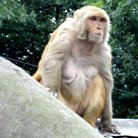Rajan had still not made it back from Nepalgunj, so Bishnu and I decided to make the trip to Mangalsen, the district headquarters of Achham district. The daylong, strikingly uphill hike would have to be made entirely by foot on an unpaved rock path in 100 degree Fahrenheit weather with 20%+ humidity. The objective? To meet with Dr. Purosotam Sedhain, the District Health Officer.
I’d only heard stories about him, but Dr. Sedhain was supposed to be a soft-spoken MBBS-MPH with more than 10 years of experience. Sedhain was our best shot at understanding how health worked in this region, and his unadvertised field work (for example, he performed 4 vasectomies while passing through a small village once) were testament to this fact. He was also the man who could procure us our vaccines, ARVs (Anti-AIDS drugs), and some key lab equipment.
That said, the trek there was possibly one of the most miserable act of physical exertion I had ever experienced. The sun blazed, my legs ached, and the loose rocky trail repeatedly betrayed my footing. The weather was also unpredictable in the mountains. The Sun could go from shining to storming and then back again in minutes, adding to my despair.
It rained. I rained sweat. Repeat.
I had two liters of boiled water with me. I’m certain I lost all of it in perspiration.
For some reason, the fact that I was going there for business took all pleasure out of the otherwise-gorgeous trail (that wound through pine woods, mango groves, and tropical forest). Towards the end, my legs were spasming from the loss of electrolytes, and I was stopping at 15-minute intervals to catch my useless breath. Nine grueling hours in, we made it to Mangalsen. Another hour to the very top of the mountain finally brought us to the
I felt rather silly as I stepped into his office, dripping sweat from my hiking attire. As I pulled my rain-soaked notebook from my muddy bag, Sedhain asked, “How was the trip?”
“Terrible,” I wheezed.
He laughed genuinely, but then he turned serious.
“That trip is a journey that hundreds of Achhamis make every year to get health care.” He gravely noted. “This is a problem.”
Over the next two hours, Dr. Sedhain then proceeded to describe the work of the District Health Office in trying to bring services to this unfortunate region. Achham is one of the remotest, least-developed, and poorest of the Nepali provinces. Unfortunately, it was also one of the hotspots of military conflict in the recently-concluded civil war. The war had left tens of thousands of Nepalis dead, and the structural damage (All of Mangalsen’s major government buildings were razed by Maoist forces—you can still see the burned-out foundations) was profound in a region that already lacks development.
Nevertheless, he provided us with some very encouraging news about the newly-implemented ARV programs and public health initiatives, and pledged his all to the Nyaya Health clinic. After that, he waxed contemplative for a moment:
“We don’t do this to print colorful brochures of all the great things we’re doing, and I hope you aren’t either,” he remarked.
“The problem with
He then chuckled softly.
“Actually, even we are just talking right now.”
“But we are trying, aren’t we?”

No comments:
Post a Comment